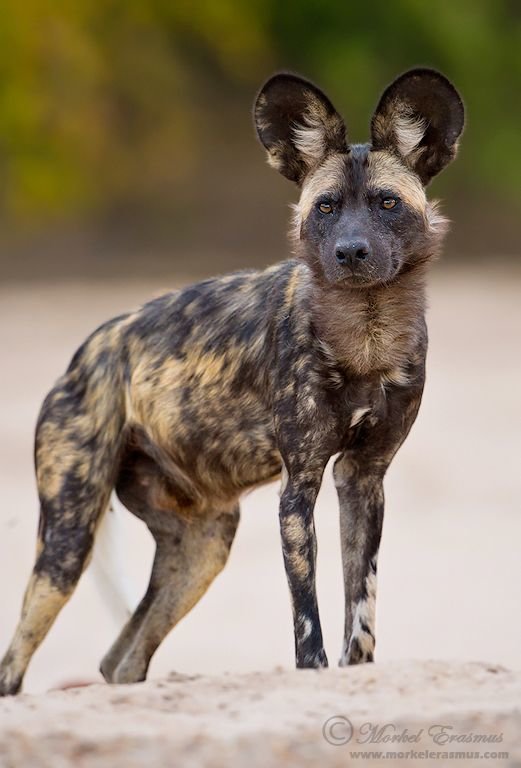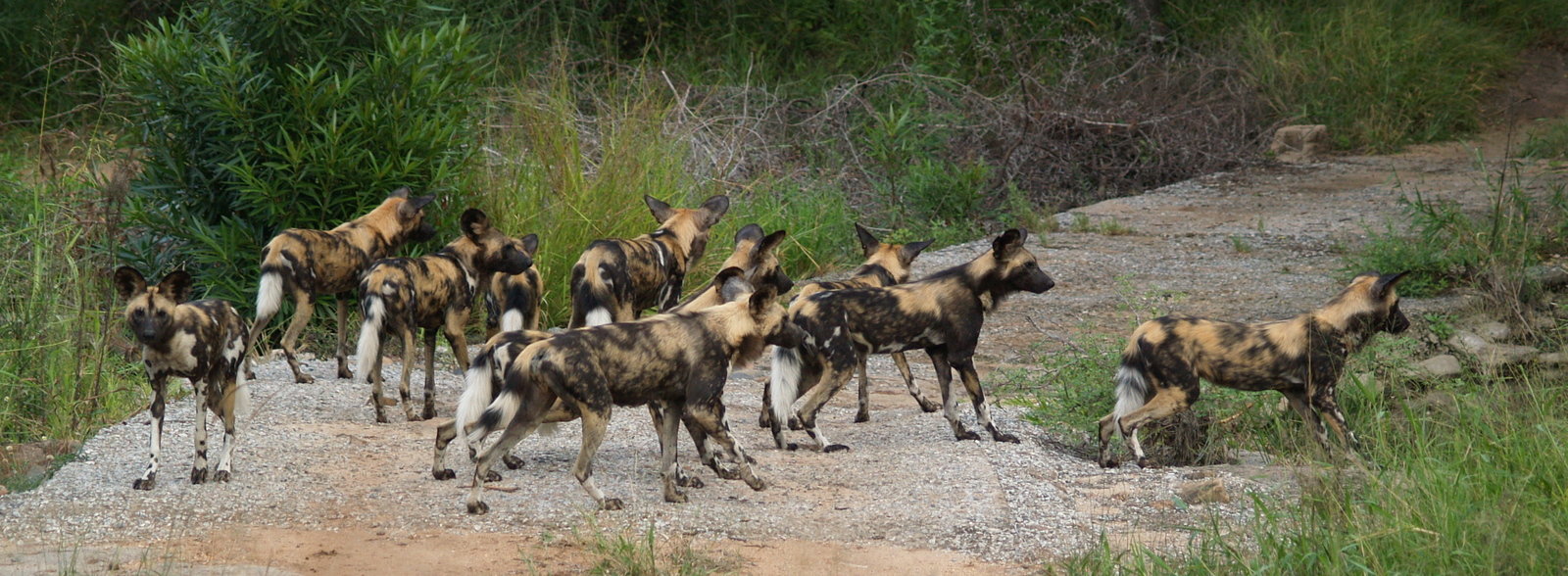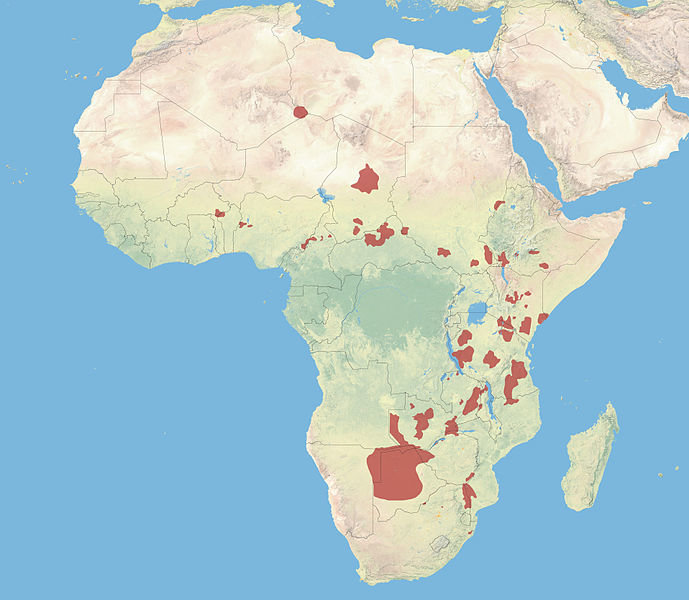Lycaon Pictus
Álvaro José Agámez Licha
Velocity Partners English Classes
Medellín, Colombia. 2016-04-13


Scientific classification
Kingdom: Animalia
Phylum: Chordata
Class: Mammalia
Order: Carnivora
Family: Canidae
Subfamily: Caninae
Tribe: Canini
Genus: Lycaon
Species: Lycaon pictus
African Wild Dog Distribution

The African wild dog, African hunting dog, or African painted dog (Lycaon pictus) is a canid native to Sub-Saharan Africa. It is the largest of its family in Africa, and the only extant member of the genus Lycaon, which is distinguished from Canis by its fewer toes and dentition, which is highly specialised for a hypercarnivorous diet. It is classed as endangered by the IUCN, as it has disappeared from much of its original range. The current population has been estimated at roughly 39 subpopulations containing 6,600 adults, only 1,400 of which are fully grown. The decline of these populations is ongoing, due to habitat fragmentation, human persecution, and disease outbreaks.
African Wild Dog
The African wild dog is a highly social animal, living in packs with separate dominance hierarchies for males and females. Uniquely among social carnivores, it is the females rather than the males that scatter from the natal pack once sexually mature, and the young are allowed to feed first on carcasses. The species is a specialised diurnal hunter of antelopes, which it catches by chasing them to exhaustion. Like other canids, it regurgitates food for its young, but this action is also extended to adults, to the point of being the bedrock of African wild dog social life. It has few natural predators, though lions are a major source of mortality, and spotted hyenas are frequent kleptoparasites.
Physical Description
African wild dog is the bulkiest and most solidly built of African canids. The species stands 60–75 cm (24–30 in) in shoulder height, and weighs 20–25 kg (44–55 lb) in East Africa and up to 30 kg (66 lb) in southern Africa. Females are generally 3–7% smaller than males. Compared to members of the genus Canis, the African wild dog is comparatively lean and tall, with outsized ears and lacking dewclaws. The middle two toepads are usually fused. Its dentition also differs from that of Canis by the degeneration of the last lower molar, the narrowness of the canines, and proportionately large premolars, which are the largest relative to body size than any other carnivore other than hyenas. The heel of the lower carnassial M1 is crested with a single blade-like cusp, which enhances the shearing capacity of the teeth and thus the speed at which prey can be consumed. This feature, termed "trenchant heel", is shared with two other canids: the Asian dhole and the South American bush dog. The skull is relatively shorter and broader than that of other canids.
The fur of the African wild dog differs significantly from that of other canids, consisting entirely of stiff bristle-hairs with no underfur. It gradually loses its fur as it ages, with older specimens being almost naked. Colour variation is extreme, and may serve in visual identification, as African wild dogs can recognise each other at distances of 50–100 metres. There is some geographic variation in coat colour, with north-east African specimens tending to be predominantly black with small white and yellow patches, while southern African ones are more brightly coloured, sporting a mix of brown, black and white coats.
Social and reproductive behaviour
The African wild dog has very strong social bonds, stronger than those of sympatric lions and spotted hyenas, thus solitary living and hunting is extremely rare in the species. It lives in permanent packs consisting of 2–27 adults and yearling pups. The average pack size in Kruger National Park and the Masai Mara is 4–5 adults, while packs in Moremi and Selous contain an average of 8–9. However, larger packs have been observed, and temporary aggregations of hundreds of individuals may have gathered in response to the seasonal migration of vast springbok herds in Southern Africa.
Males and females have separate dominance hierarchies, with the latter usually being led by the oldest female. Males may be led by the oldest male, but these can be supplanted by younger specimens, thus some packs may contain elderly former male pack leaders. The dominant pair typically monopolises breeding. The species differs from most other social species by the fact that males remain in the natal pack, while females disperse (a pattern also found in primates like gorillas, chimpanzees and red colobuses).
Hunting and feeding behaviours
The African wild dog is a specialised pack hunter of common medium-sized antelopes. It and the cheetah, are the only primarily diurnal African large predators. L. pictus hunts by approaching prey silently then chasing it in a pursuit clocking at up to 66 kilometres per hour for 10 to 60 minutes. The average chase typically only goes as far as 2 km, during which time the prey animal, if large, is repeatedly bitten on the legs, belly and anus until it stops running, while smaller prey is simply pulled down and torn apart. L. pictus hunting strategies differ according to prey, with wildebeest being rushed at in order to panic the herd and isolate a vulnerable individual, whereas territorial antelope species, which defend themselves by running in wide circles, are captured by cutting off their escape routes.
Medium-sized prey is often killed in 2–5 minutes, whereas larger prey like wildebeest may take half an hour to pull down. Male wild dogs usually perform the task of grabbing dangerous prey, such as warthogs, by the nose.
Small prey is eaten entirely, while large animals are stripped of their meat and organs, with the skin, head, and skeleton left intact. The African wild dog is a fast eater, with a pack being able to consume a Thompson's gazelle in 15 minutes. In the wild, the species' consumption rate is of 1.2–5.9 kg per African wild dog a day, with one pack of 17–43 specimens in East Africa having been recorded to kill three animals per day on average.
Unlike most social predators, it will regurgitate food for adult, as well as young family members. Pups old enough to eat solid food are given first priority at kills, eating even before the dominant pair; subordinate adult dogs help feed and protect the pups. The African wild dog is a highly successful hunter. Nearly 80% of all wild dog hunts end in a kill; for comparison, the success rate of lions, often viewed as ultimate predators, is only 10% (up to a maximun of 40% under optimal conditions).
Diet
In East Africa, its most common prey is Thomson's gazelle, while in Central and Southern Africa it targets impala, reedbuck, kob, lechwe, and springbok. Its diet is not restricted to these animals though, as it will also hunt wildebeest, warthog, oribi, duiker, waterbuck, Grant's gazelle, zebra, bushbuck, ostrich, African buffalo (especially calves), and smaller prey like dik-dik, hares, spring hares and cane rats. Certain packs in the Serengeti specialized in hunting zebras in preference to other prey. One pack was recorded to occasionally prey on bat-eared foxes, rolling on the carcasses before eating them. L. pictus rarely scavenges, but has on occasion been observed to appropriate carcasses from spotted hyenas, leopards, and lions, as well as animals caught in snares.
African Wild Dog Interesting Facts and Features
The long large intestine of the African Wild Dog means that they have a very efficient system for absorbing as much moisture from their food as possible. This gives these canines an advantage in such arid climates as they do not need to find such a regular supply of water. African Wild Dogs are therefore able to go for long periods of time without needing to drink. Unlike many other carnivores, African Wild Dogs kill their prey by starting to bite it when it is still alive. Although this may sound cruel, the animal actually dies more quickly and less painfully than if it was killed in the generally preferred way.
Lycaon Pictus
By Alvaro Agamez
Lycaon Pictus
- 910



